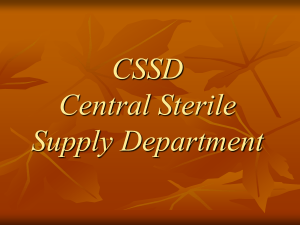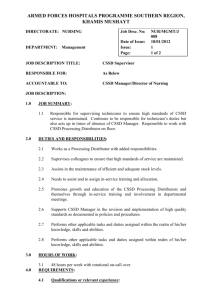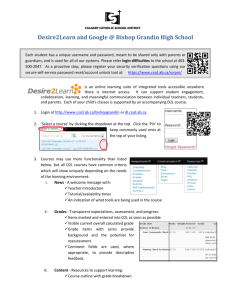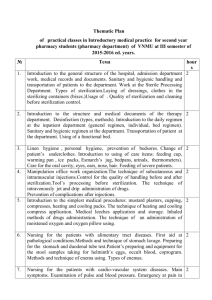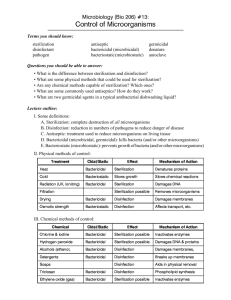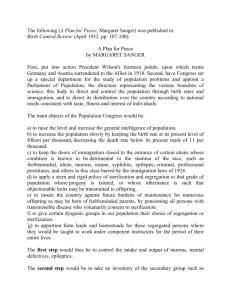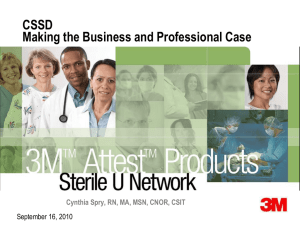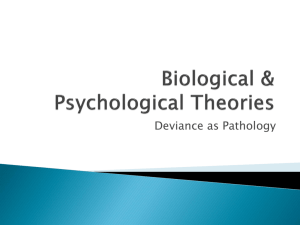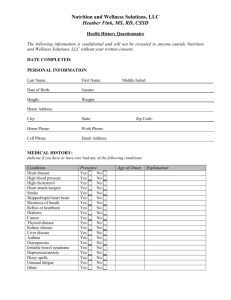Outsourcing the CSSD of an Academic Hospital: Opportunity
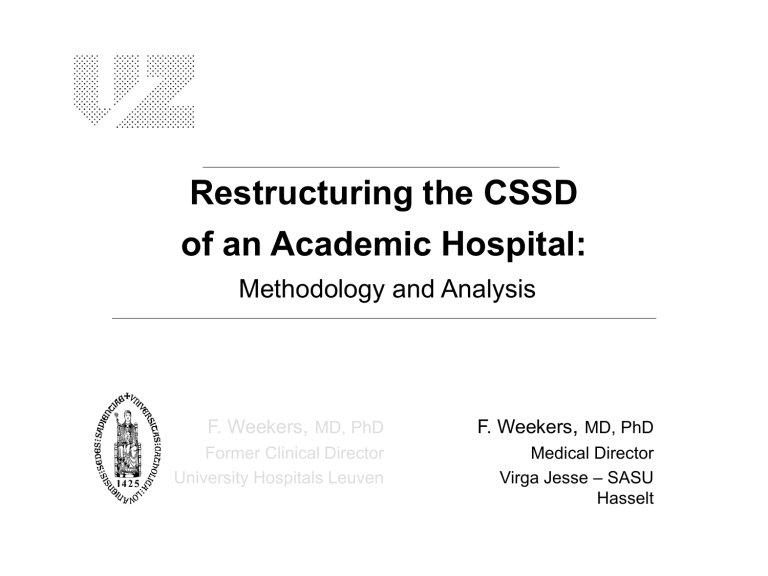
Restructuring the CSSD of an Academic Hospital:
Methodology and Analysis
F. Weekers , MD, PhD
Former Clinical Director
University Hospitals Leuven
F. Weekers , MD, PhD
Medical Director
Virga Jesse
– SASU
Hasselt
Outsourcing the CSSD of an Academic Hospital:
Opportunity Identification and Financial Analysis
F. Weekers
PTIMBAL 2006
Vlerick Leuven Ghent Management School
Project in fulfillment of the degree “Master in Business Administration”
Outsourcing Project
• Practical Frame : Key Issues
– Define the Business Outsourcing Opportunity
– Select of Vendor
– Draft the Outsourcing Contract
– Monitor, Manage and Modify the Vendor
• The CSSD Project
– Vision and Scope
– Current State Analysis
– Optimization Potential
– Financial Analysis of the Different Scenarios
– Outsourcing Opportunity Identification
Outsourcing Project
• Practical Frame : Key Issues
– Define the Business Outsourcing Opportunity
– Select of Vendor
– Draft the Outsourcing Contract
– Monitor, Manage and Modify the Vendor
• The CSSD Project
– Vision and Scope
– Current State Analysis
– Optimization Potential
– Financial Analysis of the Different Scenarios
– Outsourcing Opportunity Identification
Methodology & Analysis
• Managerial View
– Not an expert view on sterilization
– Quality driven project ➛ (economical) spin off
– Change project ➛ difficult
– Conclusions and decisions based on data
– Under-investment
• Practical – Project management Approach
– Based on the UZL project
– Interaction to learn
The Central Sterilization & Supply
Department (CSSD)
• Mission of CSSD (customer oriented)
– Timely delivery of sterile goods
– Quality (according to European Standards – EN)
– Efficiency (line process)
• Activities of the CSSD (Spaulding)
– Cleaning
– Disinfection of semi- / non critical items (mucosa – non intact skin contact)
– Sterilization of critical items (high risk for infection)
– Supply of sterile materials
The Central Sterilization & Supply
Department (CSSD)
• Building Blocks
– Well trained employees
– Information System
• Planning system: information available OR CSSD
• Tracing: set level / instrument level
– Standardization
• Processes: SOP
• Equipment and Instruments
• Infrastructure
– (External) Validation
– “Just in time” delivery – pull from the OR
Methodology & Analysis
• Why this project ?
– Suboptimal quality : deterministic for quality of surgical care
– Optimization potential: line process (<=> job shop) ➛
“manufacturing like”
– European standards
– Major investments planned
– Substantial cost center
– CSSD often neglected by management
– Inter-hospital sterilization (?)
Methodology & Analysis
The scope of the project:
– Analysis of the Current Process
• Flows
• Capacity – Efficiency measurement
• Cost Calculation of Current Sterilization Activity
– List of non - conformities
– Optimization potential of process
• state of the art concept
• Including cost of different options (instruments, labor, building, IT, ..)
Methodology & Analysis
• Methodology:
– Project Team
• Business Analysis Team
• Working Group: involvement and communication
– Surgeons
– Nurses
– CSSD and peripheral collaborators
– Management team
• Steering Committee “Optimization CSSD”
• External Consultant
– Communication plan
The Sterilization Process at the UZL
• Current State Analysis (As Is)
– Describe “AS IS”
• Process: sterilization – logistics - flow
• Infrastructure & Equipment
• HR – Organizational Structure
• QM & backup systems
• IT
• Financials
– Labor
– Investments (instruments / fixed assets)
– Consumables / materials
– IT
– Overhead
Cost per set
Cost per STU/E
Cost per year
The Sterilization Process at the UZL
• Current State Analysis (As Is)
– Evaluate (Benchmark, SWOT)
• Develop the future state (To Be)
– Concept
– Risk analysis and mitigation strategy
– Financials of the Project
The Sterilization Process in the UZL
• Paucity of data
– Units processed?
– Employees involved in the process?
– Total cost of sterilization activity?
– Manually – mechanical cleaning?
– Amount of instruments used?
– Quality of final product?
– Documentation of the process?
CSSD
OR-1 :
22 OR
OR-2 :
8 OR
The CSSD at the UZL
Dentistry
3 OR
2 OR
5 OR
The Sterilization Process at the UZL
• Data Collection
– Interview: non quantitative items
– Data collection in HIS
• Financial data (labor, consumables,..)
• Process analysis: few
– 3 month registration period at the set level:
• flow of individual sets
• (non) use of sets / volume processed at each site
• normal – urgent procedure
• manual cleaning – use of ‘express procedure’
The Sterilization Process at the UZL
• Data Collection
– Labeling of individual sets (code) / instruments
– Determination of STE per set
– Registration at every “sterilizer”
• ID set / number of sets
• Date – time
• Operator
• Cleaning method
– Registration of cleaning procedure
– Registration on paper → Access database
– …..
The Sterilization Process at the UZL
• Registration Form
The Sterilization Process at the UZL
• Data Collection
– Definitions : problematic
• STU : 30 x 60 x 30 cm
• STE : 30 x 60 cm, height 6-30 cm
• DIN : (48 x 25 x 5 cm)
• Individual sets
– Fragmented Process: diverse (91 pers)
Main Results of the Analysis
• Process Analysis
– Flow diagram
– Capacity analysis
– Instruments
Main Results of the Analysis
Main Results of the Analysis
• 1st lesson: mapping your processes unveils the ‘hidden factory’ and is the basis for further analysis
Main Results of the Analysis
• Process Analysis
– Flow diagram
– Capacity analysis
– Instruments
Results of the Analysis
Results of the Analysis
• CSSD
Stoom 1
Stoom 2
Stoom 3
Stoom 4
Stoom 5
Stoom 6
Stoom 7
Sterrad 11
Sterrad 12
Totaal
STE
Gebruik sterilisatoren
6
6
6
6
6
6
6
2
2
Aantal sets
13.244
15.763
13.338
15.578
12.261
11.887
10.986
5.908
5.944
104.908
Aantal STU Aantal cycli Gem. # cycli
/ dag
10.980
1.437
5,7
12.823
10.966
12.629
9.425
1.911
1.595
1.888
1.446
7,6
6,4
7,6
5,8
9.175
8.166
1.577
1.641
77.381
1.528
1.257
1.244
1.208
6,1
5,0
5,0
4,8
Max capaciteit Gem STU per cyclus
13.500
7,64
13.500
13.500
13.500
13.500
6,71
6,87
6,69
6,52
13.500
13.500
4.500
4.500
6,01
6,49
1,27
1,36
Rendement
Open: Monday – Friday 08:00 – 21:00h
81,3%
95,0%
81,2%
93,5%
69,8%
68,0%
60,5%
35,0%
36,5%
Results of the Analysis
• Inefficient / ineffective use of resources
Aantal
STU / jaar
Manuele reiniging per kern
Aantal uur / jaar (30 min/STU)
% manueel van totaal
STU
Kern A 3.508
Kern B 4.639
Kern C 2.351
Kern D 2.345
1.754
2.319
1.176
1.173
83,2%
137,3%
28,2%
72,1%
Kern E 4.771
Oka2 4.888
2.385
2.444
Totaal 22.502 11.251
1386,8%
73,8%
86,0%
Aantal FTE
0,9
1,2
0,6
0,6
1,2
1,2
5,7
Results of the Analysis
• Inefficient / ineffective use of resources
Set_ID
NK126
NK05
NK10
NK122
NK111
NK19
NKO (53 - 6)
Aantal sterilisaties noodzakelijk dezelfde dag => werkbaar gemiddeld gebruik (*)
Camera NKO
Boorsetjes
Mandibula
Tongakylose
H.P.M.P.C
Verhemeltje bak
Naam Aantal_Sets Minimum Maximum Gemiddeld
1 1 7 2,83
1 1 4 2,25
1
1
1
1
1
1
1
1
3
3
2
2
1,75
1,50
1,33
1,11
Aantal sterilisatie zelfde dag
3,54
2,81
2,19
1,88
1,67
1,39
Main Results of the Analysis
• 1st lesson: mapping your processes unveils the ‘hidden factory’ and is the basis for further analysis
• 2nd lesson: measurement over an extended period gives accurate data for further analysis and decision making.
The Sterilization Activity at the UZL:
Current State Analysis
Sterilisation Activity UZL : Consolidated P&L 2005
# standard cost 2005
TOTAL COSTS
DIRECT COSTS
Depreciation
Building (33y)
Disinfectors (10y)
Sterilizers (10y)
Maintenance
ICT
Infrastructure (CSSD)
Labour Cost
CSSD
Pharmacist
GHB (OR 1-2)
Pellenberg
St Pieter- St Rafael
Lubbeek
Pension plan
Operational Costs
Material used in CSSD
Material used in OR 1
Material used in OR 2
Material used in Pellenberg
Material used in Lubbeek
Material used in St Pieter-St Rafael
INDIRECT Costs
Indirect Cost / M²
Indirect Cost / VTE unit
1.815
m
2
17 disinfectors
46 sterilizers
Revenu (budget) subsection B-2 subsection A-1 (depreciation, intrests) subsection B-1: indirect costs general services
Net Profit / (Net Loss)
1.815
48,54
48,54 FTE
30,40
0,30
8,16
5,74
2,97
0,97
42.820
174.765
42.820
pm
290
7.602
4.434.522
3.539.171
100,0%
595.174
194.205
€
168.500
€
125.500
€
8.515
0 (at present no IT investment)
98.454
(furniture investment in 2005)
2.237.594
13,4%
50,5%
1.301.728
52.430
349.411
245.787
127.175
41.535
119.528
706.403
545.488
67.493
9.288
15,9%
66.127
2.220
15.787
895.351
(financ rents, general expenses, maintenance)
526.350
290€ per m 2
369.001
7602€ per FTE
2.691.963
1.774.105
398.000
519.858
-1.742.560
The Sterilization Activity at the UZL:
Current State Analysis
Main Results of the Analysis
• 1st lesson: mapping your processes unveils the
‘hidden factory’ and is the basis for further analysis
• 2nd lesson: measurement over an extended period gives accurate data for further analysis and decision making.
• 3d lesson: small units are more costly (but always take into account the level of quality i.e. infrastructure, instruments, tracing,..)
Results of the Analysis
• Sterilization process
– Manual cleaning (time pressure – habits)
– Under-use US cleaning
– Use of Statims problematic
– Variable throughput times (20 min. – 4h)
– No tracing of sets
– 1 procedure fits all (instruments)
• Infrastructure
– Small rooms
– No separation clean – contaminated
– Crowding in aisles OR
Results of the Analysis
• Organization
– Planning available day-1 but frequent changes during OR day
– Planning not communicated to CSSD
– No link between available sets and planning
– Push system to CSSD
– Inventory (of sets) in the OR
• CSSD is ISO certified / peripheral sites not
• No instrument management system (4-5 Mi0)
• Training
– 91 persons involved in sterilization
– No formal training
Results of the Analysis
• Equipment:
– No independent validation of sterilizers (UZL TD)
– No validation of washers and disinfectors
– Suboptimal use of US
– No seal test of sealing machines
• No back-up procedure
Results of the Analysis
• SWOT Analysis (team meeting)
Strengths
SWOT Analysis of the Current Process
Weakness
Location of CSSD and relation to OR
Sufficient space
OR planning system
Experience with change management
ISO certification CSSD
Multidisciplinary team meetings
Infrastructural Shortcomings
No supply management by CSSD
No tracing system
Suboptimal environment (noise and heat)
No instrument management system
Dispersion of sterilisation activities
Overcapacity
OR planning system not available for CSSD
Opening hours (5/7)
Opportunities
Under investment in training no info on peripheral sterilisation process
Threats
New headnurse CSSD
New Regulation
Willingness to improve process
Industrial partnership
Centralization
High investment costs
Involvement/Cooperation surgeons and nurses OR
The Sterilization Activity at the UZL:
Optimization Potential
• Major Suggestions
– (Partial) Centralization of sterilization activities
• quality
• redundant equipment (and labor)
– CSSD coordinates supply of sterile goods
• Space in OR
• Cost (instruments??)
• premises:
– Planning available to CSSD
– 24/7 opening
The Sterilization Activity at the UZL:
Optimization Potential
• Other suggestions
– Strict separation of different zones
– Updating of (some) equipment
– Tracing system
– Instrument management system
– Quality Management System (cfr. NIAZ)
– Training of Employees
The Sterilization Activity at the UZL:
Financial Implications of the Different Options
Options
• State of the art activity at all sites (maintain current number of sites)
• Centralization of all sterilization activities on 2 sites
The Sterilization Activity at the UZL:
Financial Implications of the Different Options
Methodology
• Accounting Approach
• Cash flow approach & NPV (discounted at 5%)
– 1$ today ≠ 1$ tomorrow
• Inflation
• Opportunity Cost of Money
– Interest of financial manager is the future accounting
– NPV =
S
CIF t
- I
(1+r) t
The Sterilization Activity at the UZL:
Option 1: state of the art exploitation at current sites
The Sterilization Activity at the UZL:
Option 1: consolidation current activities
The Sterilization Activity at the UZL:
Option 1: consolidation current activities
The Sterilization Activity at the UZL:
Option 2: centralization at 2 sites
Investment in Small Surgical Instruments
Investment in Small Surgical Instruments
The CSSD: Conclusions
• Critical for core business
• Underinvestment by management
• Major improvements: Q ➛ €
• Analysis based on data is feasible
• Expert input advised (internally externally)
• Standardization of processes – equipment instruments
• Financial Analysis based on cash flow
• Change project ➛ early communication
Acknowledgements
• Head Nurses and Employees of CSSD and OR
• Management Team of the CC department
• J. Bessemans, Besco bvba
• Company Sterima – Vanguard
• Prof. P Gemmel, VLGMS
